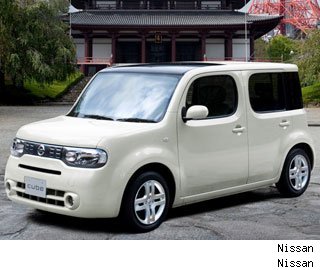Odd-Looking cars

-

- Image Credit: Nissan
Nissan Cube
2009 to Present
Sales: 22,968 in 2010, and 8,677 through April 2011, down 23% from the previous year.
The Cube sold in Japan before being imported to the U.S. Nissan believed there would be a market for the square box-car among young drivers in particular, who would find it hip. According to Nissan designers, the interior is inspired by the "enveloping curves of a jacuzzi to promote a comfortable and social atmosphere." The decision was made to mimic Toyota's decision to export the similarly boxy Scion xB from Japan. Sales have fallen off from initial interest faster than anticipated. -
- Image Credit: DVS1mn, Flickr
Ford Edsel
1958-60
Sales: 84.000 were recorded as sold, though 120,287 were recorded as built.
The Edsel was meant to be a new division at Ford, and the company hyped the car for a couple of years as being a breakthrough design that pointed to the future. Instead, the car was viewed as a major disappointment given the hype, as dealers and the media couldn't figure out why Ford had bothered to make it since it didn't seem to deliver anything unique that couldn't be found in a Ford, Mercury or Lincoln. -
- Image Credit: Wikipedia
AMC Gremlin
1970-78
Sales: 671,475
It's hard to call the Gremlin unsuccessful even though it is considered one of the homelier designs ever to come out of Detroit. It is actually the top selling single model that American Motors ever turned out, owing in part to the fact that went almost nine years without major update on a single chassis design. The April 6, 1970 cover of Newsweek magazine featured a red AMC Gremlin for its article, "Detroit Fights Back." Kiplinger's personal finance magazine, Changing Times, listed the AMC Gremlin as first among the best subcompact used cars as "selected by top mechanics for good value, good service." -
- Image Credit: Wikipedia
AMC Pacer
1975-80
Sales: 145,000 sold the first year, but only 280,000 over five years.
The Pacer was a fishbowl on wheels. It was a bold, if ugly, design experiment, having been designed from the inside out. Indeed, the point of the Pacer was to build a car around the needs of the typical driver, rather than come up with an exterior design first. -
- Image Credit: Ford
Lincoln Blackwood
2002
Sales: 3,356 were sold over two years, though the truck had only one official model year.
The Blackwood was only available with a black exterior and interior. The truck bed was redone as a trunk, with a power tonneau, which was the source of huge quality problems, and plush carpeting. The box was manufactured from plastic composites but lined with stainless steel. The exterior of the bed featured aluminum pinstripes over artificial burled black wood. It was a truck that nobody was asking for, but that didn't stop Ford from building it. -
- Image Credit: GM
Saturn Ion Coupe
2004-2007
Sales: Actual number for coupe sales is elusive, but it wasn't great.
The Ion in general was a big disappointment for the now-defunct Saturn division. The instrument cluster was in the center of the dash, instead of in front of the driver. And the coupe version had a third door on just one side of the car. Besides those two design oddities, the car was viewed by former GM vice chairman and head of product development, who inherited the Ion from a previous regime, as the poster-car for everything that was wrong with GM. -
- Image Credit: GM
Pontiac Aztek
2001-2005
Sales: Its best year was 27,793 in 2004.
The Aztek arrived on the scene as the "crossover" SUV was taking off. But GM's decision to build the car atop the engineering platform of what had been a pretty unsuccessful minivan made the proportions of the car awkward and odd and ungainly. It has often been named to "Ugliest cars of all time" lists. Like a Bulldog, though, its owners, the few of them that there were, loved the vehicle, and so GM says it was one of their highest "customer satisfaction" triumphs since they started tracking that measurement. -
- Image Credit: Honda
Honda Element
2003-2011
Sales: Less than 14,000 in 2010, but 67,418 in its best year and 325,000 total.
With those kinds of numbers, can we really call the Element a failure? It was conceived as an activity vehicle that would attract young, active twenty-somethings. The rear seats folded flat, and then up to the side walls of the interior, creating a spacious interior for camping, or hauling bicycles, kayaks and the like. The urethane floor makes it so the car could literally be hosed out as one would do with a pickup bed. In fact, the average age buyer for the Element was well over 40, and few young people were attracted to it. -
- Image Credit: GM
Hummer H2
2002-2010
Sales: The hulking SUV cost over $50,000 and sold 152, 939 copies, including the SUT pickup version, in seven years.
Adapted from the he chassis of the Chevy Suburban, the car was made to be a street-legal substitution for the military Hummer H1 vehicle that rose to fame in Operation Desert Storm. The design was brutal, but appealed to people whose idea of taste runs to the biggest houses, the biggest guns and the biggest SUVs. It was profitable for GM, but it also caused a lot of collateral damage to the company's image. It became an icon of excess and gas guzzler development for which environmentalists relentlessly criticized GM. By 2009, when GM went through bankruptcy, sales were anemic, the image was toxic and no buyers other than a not-so-serious one from a Chinese company, materialized. GM shuttered the brand in 2009, though dealers were still selling leftover stock of H2s and the smaller H3s into 2010.







